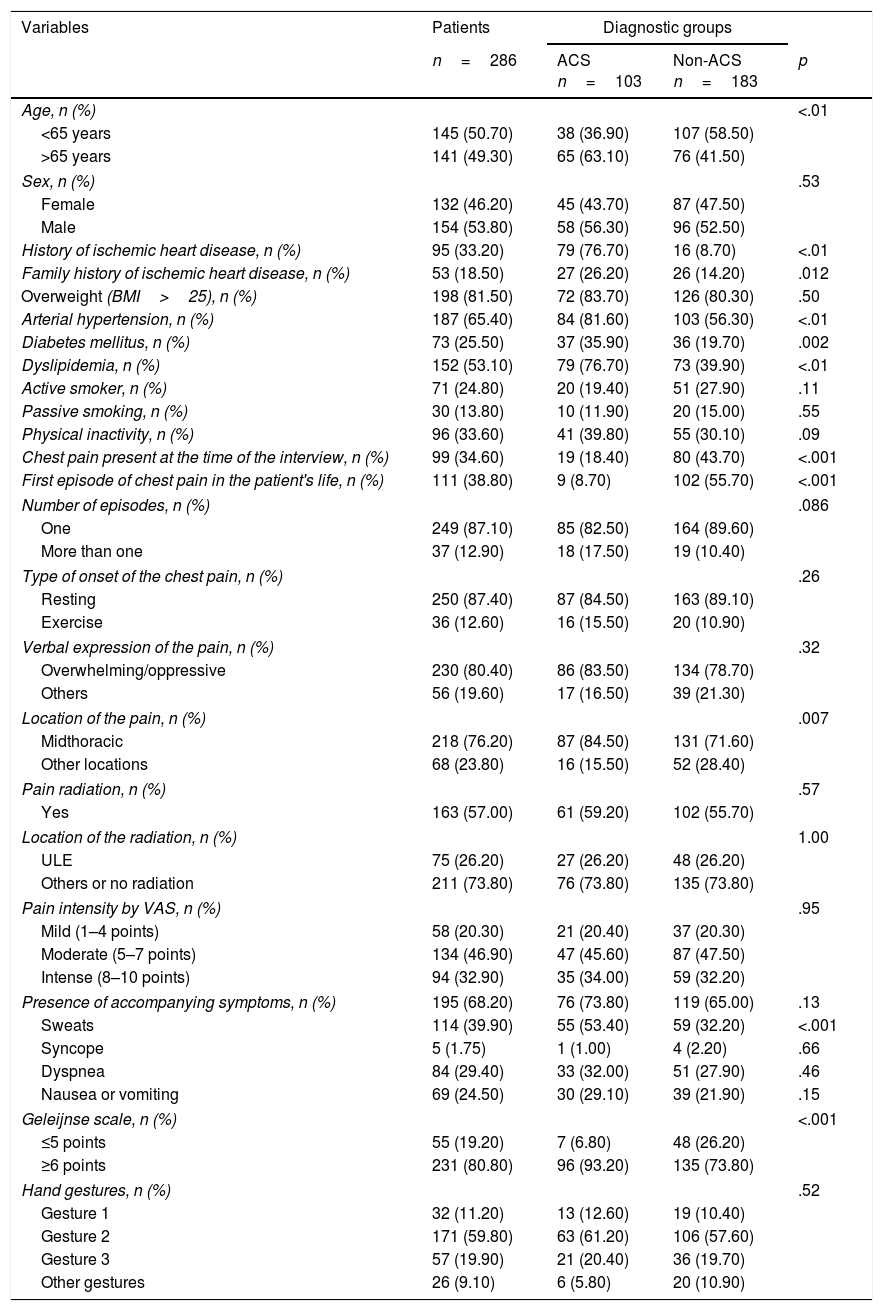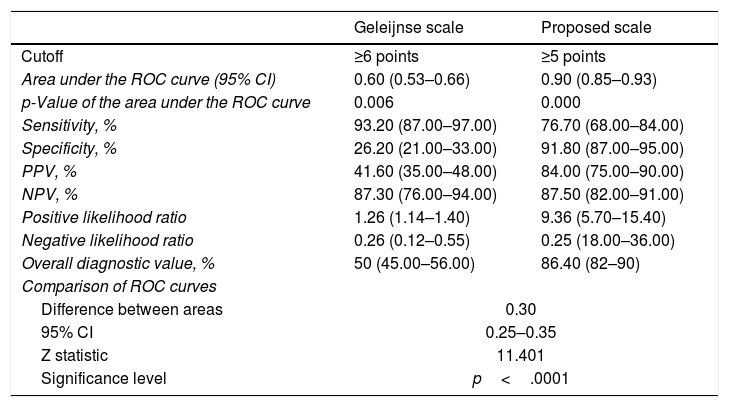Acute coronary syndrome (ACS) requires improved diagnostic accuracy through useful, safe and easy-to-apply tools.
ObjectivesTo obtain an assessment scale for the diagnosis of ACS in patients with chest pain and nondiagnostic electrocardiogram and troponin concentrations.
MethodsA prospective cohort study included 286 patients treated in the emergency department for chest pain, with normal electrocardiogram and troponin levels. Using multiple logistic regression, we obtained the independent predictors for the diagnosis of ACS. The assessment scale's discriminative power was assessed with the area under the ROC curve.
ResultsThe diagnosis of ACS was confirmed in 103 patients (36%). The final predictive model included 3 endpoints: a history of coronary artery disease, hyperlipidaemia and a score≥6 points on the Geleijnse scale. The area under the ROC curve for the final model was 0.90 (95% confidence interval [95% CI] 0.85–0.93). A threshold of 5 points achieved a sensitivity of 76.7% (95% CI 68–84), a specificity of 91.8% (95% CI 87–95), a positive likelihood ratio of 9.36 (95% CI 5.70–15.40), a negative likelihood ratio of 0.25 (95% CI 18.00–36.00) and an overall diagnostic accuracy of 86.4% (95% CI 82–90). The predictive model was superior to the Geleijnse scale alone.
ConclusionsThe final scale showed good discriminative capacity for diagnosing ACS and could therefore be of interest for identifying ACS in emergency departments. Nevertheless, the scale needs to be validated in larger multicentre studies.
El síndrome coronario agudo (SCA) requiere una mejora de la precisión diagnóstica mediante herramientas útiles, seguras y fácilmente aplicables.
ObjetivosObtener una escala de valoración para el diagnóstico de SCA en pacientes con dolor torácico y electrocardiograma y concentraciones de troponina no diagnósticas.
MétodosEstudio de cohortes prospectivo que incluyó 286 pacientes atendidos en Urgencias por dolor torácico, con electrocardiograma y troponina normales. Mediante regresión logística múltiple se obtuvieron las variables independientes predictoras del diagnóstico de SCA. El poder discriminativo de la escala de valoración se evaluó mediante el área bajo la curva ROC.
ResultadosEl diagnóstico de SCA se confirmó en 103 pacientes (36%). El modelo predictivo final incluyó 3 variables: antecedentes personales de enfermedad coronaria, hiperlipidemia y una puntuación en la escala de Geleijnse≥6 puntos. El área bajo la curva ROC para el modelo obtenido fue de 0,90 (intervalo de confianza al 95% [IC 95%] 0,85-0,93). Un umbral de 5 puntos obtuvo una sensibilidad del 76,7% (IC 95% 68-84), una especificidad del 91,8% (IC 95% 87-95), un cociente de probabilidad positivo de 9,36 (IC 95% 5,70-15,40), un cociente de probabilidad negativo de 0,25 (18,00-36,00) y una precisión diagnóstica global del 86,4% (IC 95% 82-90).El modelo predictivo fue superior a la escala de Geleijnse aislada.
ConclusionesLa escala de puntuación obtenida mostró una buena capacidad discriminativa para el diagnóstico de SCA, por lo que podría ser de interés para identificar el SCA en los servicios de Urgencias. No obstante, se precisa su validación mediante estudios multicéntricos más amplios.
Article
Diríjase desde aquí a la web de la >>>FESEMI<<< e inicie sesión mediante el formulario que se encuentra en la barra superior, pulsando sobre el candado.

Una vez autentificado, en la misma web de FESEMI, en el menú superior, elija la opción deseada.

>>>FESEMI<<<











